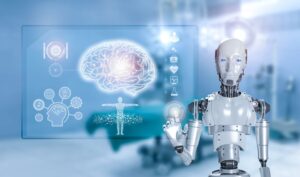Introduction
Artificial Intelligence (AI) has emerged as a transformative force across various domains, reshaping industries, enhancing efficiency, and pushing the boundaries of innovation. From autonomous vehicles to healthcare diagnostics, AI applications continue to proliferate, showcasing its vast potential to revolutionize the way we live, work, and interact with technology.
Impact across different sectors:
Automation and Efficiency:
One of the primary strengths of AI lies in its ability to automate tasks and processes, leading to increased efficiency and productivity. Machine learning algorithms, a subset of AI, enable systems to learn from data and improve performance over time without explicit programming. This capability has paved the way for automation in various industries, ranging from manufacturing and logistics to customer service and finance. AI-powered automation streamlines workflows reduces errors, and frees up human resources to focus on more complex and creative endeavors.
Predictive Analytics and Decision Making:
AI excels in analyzing vast amounts of data to uncover patterns, trends, and insights that may not be immediately apparent to human analysts. Through techniques such as predictive analytics and data mining, AI systems can anticipate future outcomes and inform decision-making processes. Businesses leverage AI-driven predictive models for demand forecasting, risk management, customer behavior analysis, and personalized recommendations. By harnessing the power of AI, organizations gain a competitive edge by making data-driven decisions with greater accuracy and foresight.
Natural Language Processing (NLP) and Communication:
Natural Language Processing (NLP) empowers machines to understand, interpret, and generate human language, enabling seamless communication between humans and computers. Virtual assistants like Siri, Alexa, and Google Assistant leverage NLP algorithms to comprehend spoken commands and respond in natural language. NLP also finds applications in sentiment analysis, chatbots, language translation, and content summarization. As NLP technologies advance, the potential for more sophisticated human-computer interaction continues to expand, driving improvements in user experience and accessibility.
Computer Vision and Image Recognition:
Computer vision enables machines to interpret and analyze visual information from images and videos, mimicking human perception to identify objects, scenes, and patterns. AI-powered image recognition systems are utilized in diverse fields, including autonomous vehicles, medical imaging, surveillance, and facial recognition. Advanced computer vision algorithms can detect anomalies, classify objects, and extract valuable insights from visual data, enhancing decision-making capabilities and enabling innovative applications in fields such as augmented reality and robotics.

Healthcare and Medical Diagnosis:
In the healthcare industry, AI holds tremendous promise for revolutionizing patient care, diagnosis, and treatment. Machine learning algorithms analyze medical imaging scans to assist radiologists in detecting abnormalities and diagnosing diseases at an early stage. AI-powered diagnostic tools can analyze patient data, genetic information, and clinical records to personalize treatment plans and predict disease progression. Additionally, AI-enabled robots are being developed to assist in surgeries, rehabilitation, and eldercare, augmenting the capabilities of healthcare professionals and improving patient outcomes.
Autonomous Systems and Robotics:
AI plays a pivotal role in enabling autonomy in various systems, including autonomous vehicles, drones, and robotic platforms. Self-driving cars leverage AI algorithms for navigation, perception, and decision-making, with the potential to enhance road safety and transform transportation networks. In industrial settings, AI-driven robots automate repetitive tasks, perform complex maneuvers, and adapt to dynamic environments, increasing efficiency and flexibility in manufacturing and logistics operations. As AI technology advances, autonomous systems will continue to evolve, unlocking new possibilities for automation and innovation.
Personalization and Recommendation Systems:
AI-driven recommendation systems are ubiquitous in today’s digital landscape, shaping our online experiences by providing personalized content, product recommendations, and targeted advertisements. These systems analyze user preferences, behavior, and historical data to deliver relevant and engaging recommendations, driving customer engagement and retention. Whether it’s streaming platforms recommending movies and music or e-commerce websites suggesting products based on past purchases, AI-powered personalization enhances user satisfaction and drives business revenue through tailored experiences.
Environmental Sustainability and Resource Management:
AI is increasingly being applied to address pressing environmental challenges and promote sustainable practices across various sectors. From optimizing energy consumption and reducing waste to monitoring biodiversity and combating climate change, AI-powered solutions are driving innovation in environmental sustainability. Smart grid systems leverage AI algorithms to optimize energy distribution and consumption, while precision agriculture employs AI sensors and drones to enhance crop yields and minimize resource usage. By harnessing AI for environmental stewardship, organizations and governments can work towards a more sustainable and resilient future.
Conclusion
Artificial Intelligence encompasses a vast array of capabilities that are reshaping industries, driving innovation, and transforming the way we live and work. From automation and predictive analytics to natural language processing and healthcare diagnostics, AI applications continue to proliferate, offering unprecedented opportunities for progress and prosperity. As AI technology evolves and matures, it is essential to navigate ethical, regulatory, and societal considerations to ensure that its benefits are realized equitably and responsibly. By harnessing the transformative power of AI, we can address complex challenges, unlock new frontiers of discovery, and create a better future for humanity.
Visit our Instagram for more updates and tips.
